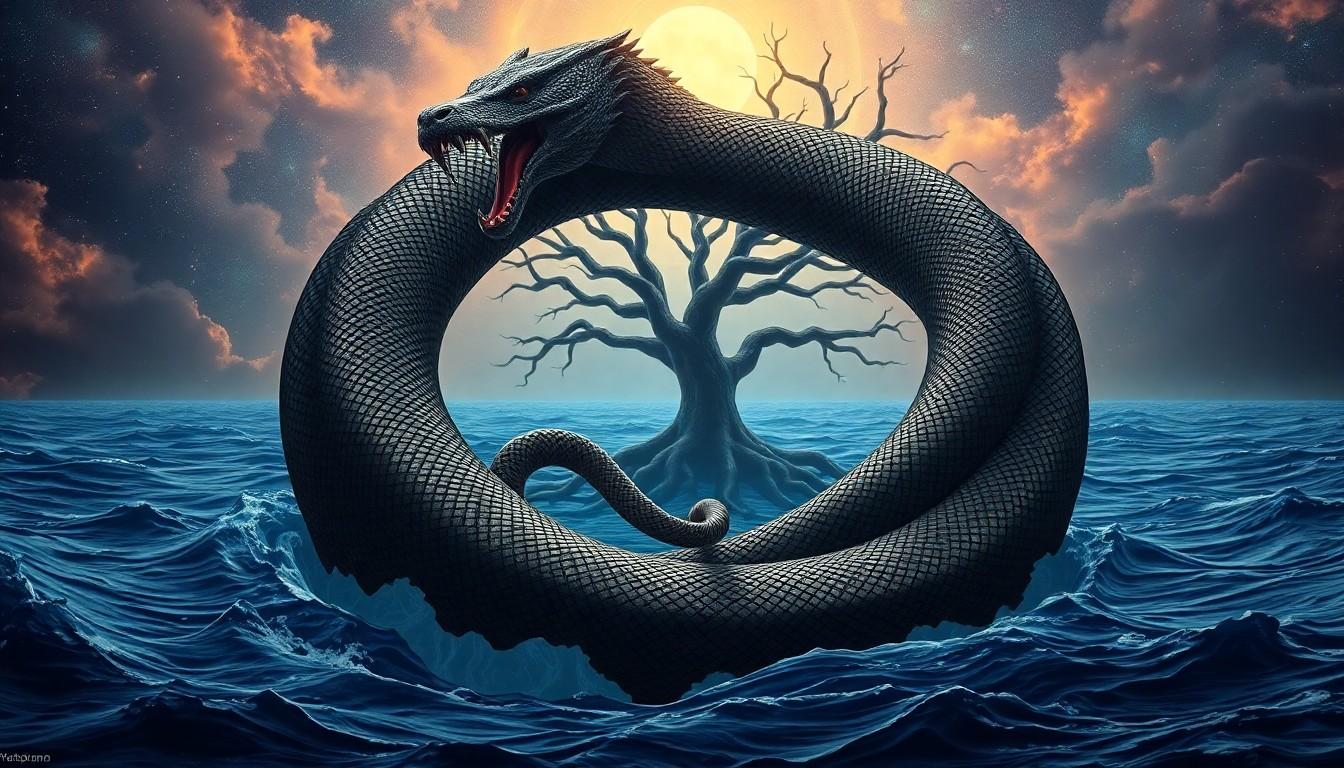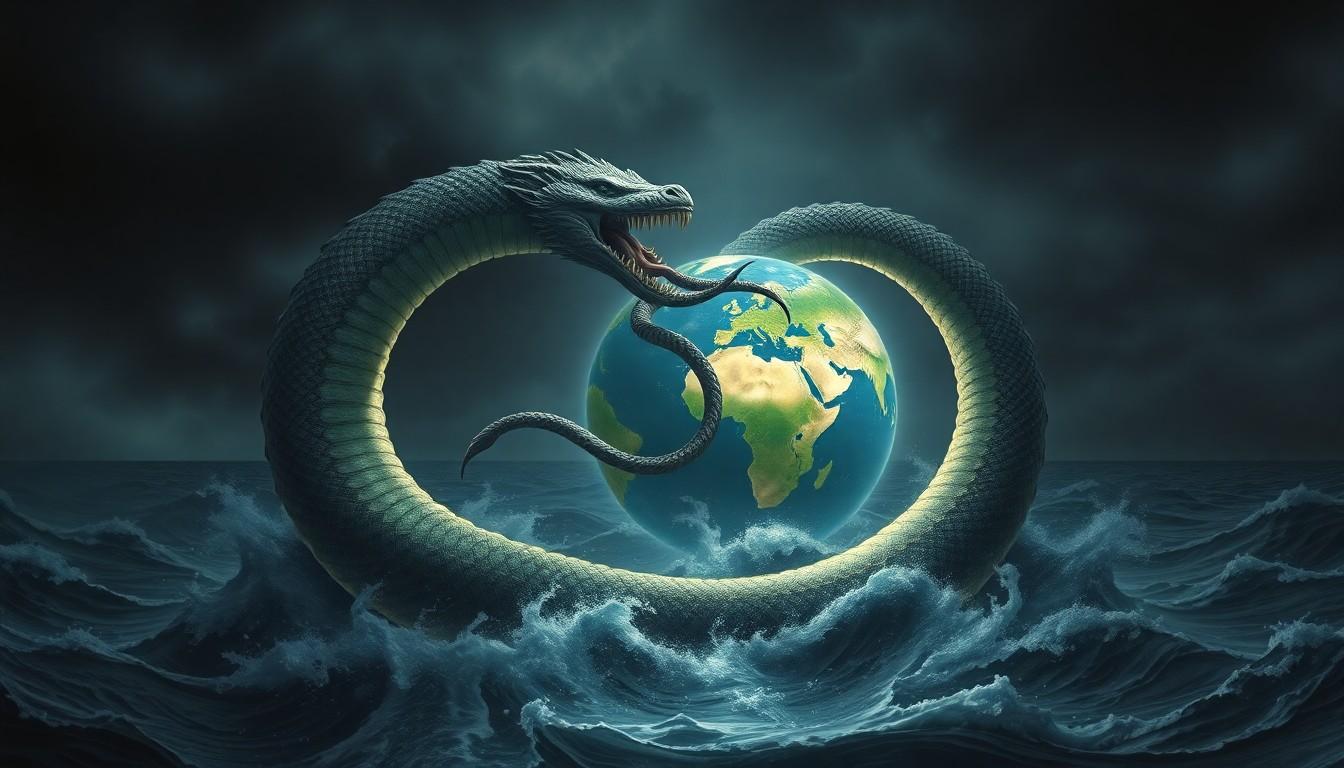In Norse mythology, Jörmungandr is one of the most formidable creatures ever conceived—a serpent so massive it encircles the entire world. Known as the Midgard Serpent or World Serpent, this mythical beast plays a crucial role in Norse cosmology and the prophecies of Ragnarök.
The name Jörmungandr derives from Old Norse, combining “jörmun” (meaning great, huge) and “gandr” (magic staff or wand). This serpentine offspring of the trickster god Loki and giantess Angrboða embodies the chaotic forces of nature and serves as a constant reminder of the delicate balance between order and chaos in Norse mythology.
The Norse Origins of Jörmungandr
Who is Jörmungandr?
Jörmungandr emerges from Norse mythology as the colossal Midgard Serpent. This mighty creature is one of three offspring born to the trickster god Loki and the giantess Angrboda, alongside siblings Fenrir, the wolf, and Hel, the goddess.
Etymology of the Name
The name Jörmungandr combines two distinct Old Norse elements that reflect its legendary status:
- Jǫrmun: Represents concepts of:
- Enormous size
- Vast expanse
- Superhuman scale
- Gandr: Encompasses meanings related to:
- Elongated supernatural entities
- Natural formations (fjords, rivers)
- Magical objects (staffs, bindings)
The combination creates multiple interpretations, including:
- The Vast Serpent
- The Great River
- The Mighty Staff
- The World Binding
These translations connect directly to Jörmungandr’s role as the serpent encircling Midgard, creating a linguistic link between the creature’s name and mythological function. The term reflects its physical form as a serpent and its cosmic role in Norse mythology.
| Name Element | Origin | Core Meaning |
|---|---|---|
| Jǫrmun | Old Norse | Huge/Vast |
| Gandr | Old Norse | Supernatural Entity |
Understanding Jörmungandr’s Role in Norse Mythology

Jörmungandr is the colossal serpent cast into the cosmic ocean by Odin, a pivotal figure in Norse mythology. The serpent’s presence influences the balance of the Norse cosmos through its interactions with gods and its connection to Yggdrasil.
The World Serpent and Yggdrasil
The World Serpent encircles Midgard, the realm of humans, in the cosmic ocean surrounding Yggdrasil. Its massive body stretches worldwide, grasping its tail in an endless circle called Ouroboros. This positioning maintains cosmic equilibrium by:
- Containing the oceans within its coils
- Supporting the structure of the world tree Yggdrasil
- Creating boundaries between the mortal realm and the cosmic sea
- Odin’s decision to cast Jörmungandr into the ocean
- Thor’s repeated encounters with the serpent during fishing expeditions
- The prophecy of Thor’s fatal battle with Jörmungandr during Ragnarök
| Event | Participants | Outcome |
|---|---|---|
| Initial Banishment | Odin, Jörmungandr | Serpent cast into the cosmic ocean |
| Fishing Expedition | Thor, Jörmungandr | Thor fails to kill the serpent |
| Ragnarök | Thor, Jörmungandr | Both die from their wounds |
Symbolic Meaning of the Midgard Serpent

Jörmungandr embodies deep symbolic significance in Norse mythology as the World Serpent. The creature’s massive form encircling Midgard represents fundamental cosmic principles that govern the Norse understanding of existence.
Representation of Chaos and Order
Jörmungandr symbolizes the delicate balance between chaos and cosmic order. The serpent’s position as an ouroboros, biting its tail while encircling the world, creates a perfect circle that maintains the boundaries of existence. This eternal cycle represents both the stability of the cosmos and its potential destruction, as the release of Jörmungandr’s tail marks the beginning of Ragnarök.
Connection to Natural Forces
The Midgard Serpent’s presence in the cosmic ocean symbolizes the raw power of nature’s elemental forces. As a creature dwelling in the world-encircling sea, Jörmungandr represents:
- Water’s dominion over the mortal realm
- Cosmic boundaries between order and chaos
- Natural cycles of creation and destruction
- Primal forces that shape the physical world
The serpent’s massive size and ability to affect ocean tides demonstrate the interconnection between mythological beings and natural phenomena in Norse cosmology. Its presence is a constant reminder of nature’s overwhelming power and humanity’s place within these cosmic forces.
Jörmungandr in Norse Prophecies

Jörmungandr’s central role in Norse prophecies centers around Ragnarök, the prophesied end of the world. The serpent’s actions trigger significant events that lead to the final battle between gods and giants.
Role in Ragnarök
The prophecy details Jörmungandr’s release from the cosmic ocean during Ragnarök, marking the beginning of world-ending events. The serpent releases its tail, which previously maintained cosmic stability, causing catastrophic floods throughout the nine worlds. During the final battle, Jörmungandr faces Thor in a legendary confrontation where:
- Thor strikes the serpent with Mjölnir, his mighty hammer
- Jörmungandr releases deadly venom into the air
- Thor emerges victorious but walks nine steps before succumbing to the serpent’s poison
- Both beings perish in this mutual destruction
| Ragnarök Event | Consequence |
|---|---|
| Tail Release | Worldwide floods |
| Poison Release | Air contamination |
| Battle with Thor | Death of both beings |
| Post-battle | Thor’s nine steps |
The prophecies emphasize Jörmungandr’s dual role as a maintainer of cosmic order and an agent of its destruction. Its presence in Norse mythology symbolizes the inevitability of cosmic cycles where creation leads to destruction followed by renewal.
Modern Cultural Impact and References
Jörmungandr’s influence extends into contemporary media across multiple entertainment platforms. Marvel Comics incorporates the World Serpent into its Thor series, portraying it as a formidable sea serpent antagonist to the thunder god.
Popular video games feature Jörmungandr in various interpretations:
- God of War (2018) presents the World Serpent as a colossal ally
- Age of Mythology includes it as a mythological unit
- Smite features Jörmungandr as a playable character
- Assassin’s Creed Valhalla integrates the serpent into its Norse-themed storyline
Literature adapts the World Serpent’s mythology in contemporary works:
- Neil Gaiman’s “Norse Mythology” provides a modern retelling
- Rick Riordan’s “Magnus Chase” series incorporates Jörmungandr
- The comic series “Hellboy” references the World Serpent in its mythology
Modern interpretations often emphasize these aspects of Jörmungandr:
- Environmental symbolism (representing ocean preservation)
- Cosmic balance (depicting cycles of destruction regeneration)
- World-ending prophecies (paralleling current ecological concerns)
The serpent’s image appears in:
- Fantasy art collections
- Tattoo designs
- Metal band logos
- Board game illustrations
- Digital art platforms
This cultural adaptation demonstrates Jörmungandr’s enduring relevance in modern storytelling. It transitions from ancient Norse mythology to contemporary entertainment media while maintaining its core symbolic significance.
Conclusion
The enduring legacy of Jörmungandr extends far beyond its origins in Norse mythology. This mighty World Serpent represents the delicate balance between chaos and order while serving as a powerful symbol of nature’s cyclical forces. From ancient sagas to modern entertainment, its influence continues to captivate audiences worldwide.
Today’s interpretations of Jörmungandr in various media forms prove that this legendary creature’s symbolism remains relevant. Its dual role as both protector and destroyer of the cosmic order resonates deeply with contemporary themes, especially regarding environmental balance and humanity’s relationship with nature.

